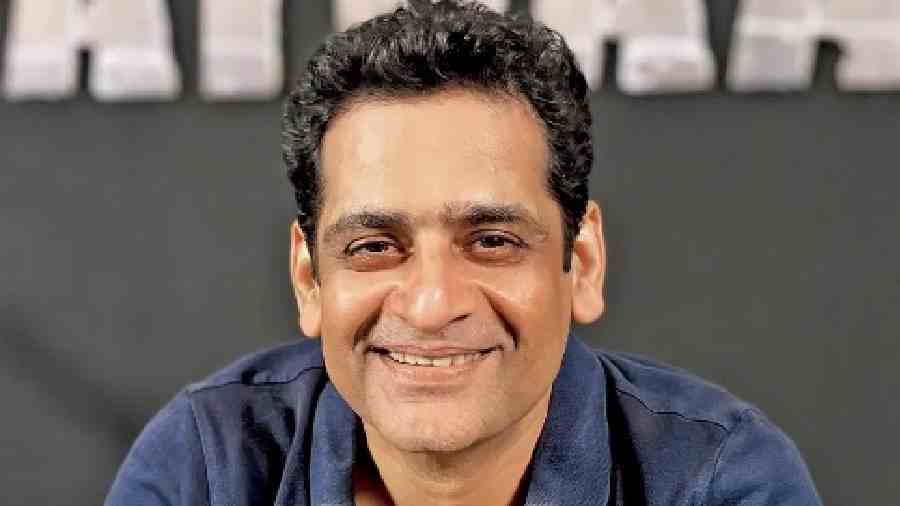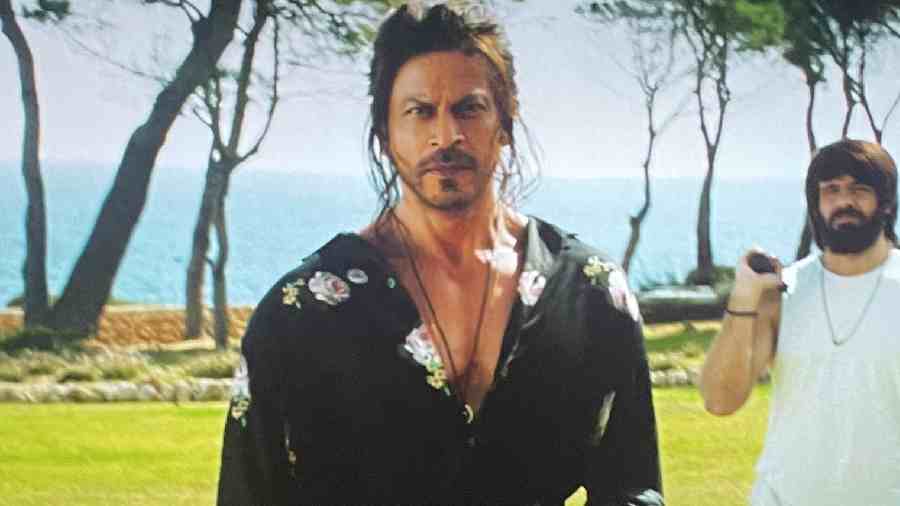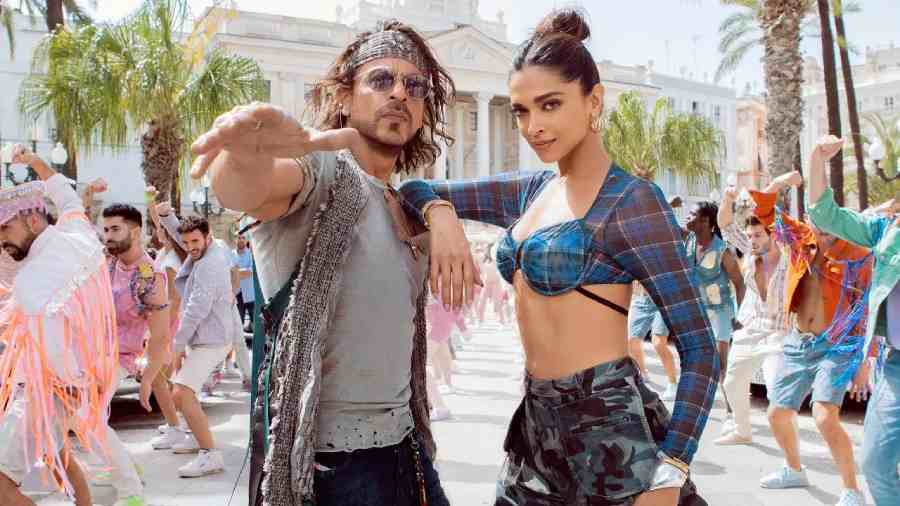Along with producer Aditya Chopra and director Siddharth Anand, Shridhar Raghavan is the man behind the design and details of Pathaan, and also of the larger Yash Raj Films spy universe. Credited with writing the screenplay for Pathaan, as well as for War before that, Shridhar is the mentor-writer of the YRF spy universe. Even as the Shah Rukh Khan-powered film continues to rake in crores, The Telegraph caught up with Sridhar for a freewheeling chat on the world of the film and fashioning the spy universe.

Shridhar Raghavan
Pathaan makes and breaks a new record almost every day. To be such a major part of it and see it do so well must be a party for you every day...
It’s exhilarating when a film that you are involved with connects with people on such a large scale. Any of us who do any kind of writing, what you are essentially looking at is establishing some connect. So when people react the way they are doing to Pathaan, then you say, ‘Okay, something connected’.
YRF (Yash Raj Films) gave Mr Khan (Shah Rukh) the ultimate romantic hero image, and now also to give him a great action role which also works for him... one feels just good to be part of it.
It’s also pretty awe-inspiring. I am from a generation that used to throw coins at the screen in theatres. For a long time, one didn’t see that happening at the single-screen theatres. Because there are so many theatres nowadays, one really doesn’t get to see a ‘housefull’ board that much. You don’t get to see people thronging to theatres because now there are 25 shows of a film at one venue.
Pathaan has been kind of time-traveling to back when we were kids in the theatre watching Mr (Amitabh) Bachchan in Kaala Patthar... we were like, ‘wow, this is cinema!’ Pathaan has made my kids react the way I would have reacted... makes me feel... (pauses) in Hindi, there is a word ‘sukoon’ (smiles).
The euphoria around Pathaan has made even the multiplexes turn into single-screen theatres...
I haven’t been out of the city after the film has released, so I am not sure about other places. But in Bombay, it was lovely to see the whistling and clapping and cheering and the audience empathising and relating to what’s happening to the characters.
Being mentor-writer of the YRF spy universe must come with a huge amount of responsibility...
I have been involved with YRF and its spy universe in the last two films (War and Pathaan). And yes, I have also written the screenplay for the third part of Tiger (Tiger 3). There are many other things planned.
The credit for the genesis of the spy universe, of course, goes to Mr Aditya Chopra (head honcho of YRF) because it was his idea to create a universe like this. To marry these characters together, to ensure that each personality is very, very different... the idea of where all this was going purely came from him.... On a conceptual level, this is purely his baby. I am there helping him design it.
A word like ‘mentor’ is lovely and fabulous (smiles), but the truth is that right now I am writing films for the spy genre. There may be certain films of a different genre within the spy universe where I may not be the right guy to write. So other writers will come in, but he (Chopra) will always be there at the head of it. So if there is anybody who is genuinely the mentor and genuinely the creative vision behind it, it’s him. I am an extension of that. But yes, it’s sweet to be referred to as a mentor and stuff! (Laughs)
Honestly, it’s a lot of fun. I love the genre, I like the space.... War is not my story. He (Adi Chopra) and Sid (Siddharth Anand, director of War and Pathaan) came to me after they had conceptualised War. I did the screenplay... I expanded it, I rooted it, I did all those things. But the genesis of the material is to their credit, so also is the fact that they managed to convince all the people involved in the project and make the required investments.
This is a very, very costly proposition, very large. That’s what happens when you make blockbuster cinema. I know that we have these demarcations of story writer, screenplay writer, dialogue writer... but in our case, it is very porous. Sid had the story, Adi sir had the concept and characters... we all sat and brainstormed, we did outlines.... inputs came in from everyone, from Abbas Tyrewala, (dialogue writer). By the time the film was made, it was very hard to sit and point out, ‘This is mine. that is yours’ (laughs). A lot of the humour comes from Abbas, the larger-thanlife spectacle comes from Sid, I brought in the rootedness, plotting and design....
Some of the best scenes I see people reacting to, I didn’t write those scenes! (Smiles) With all humility and honesty, I would say that it really is a collaborative effort. Bracketing us under different roles is just lip service.
For the film, the editing played a major part. A lot of this film’s crispness and pace happened on the editor’s table. Technically, editing is also part of the writing process.
I am just happy that the film worked in totality. And because it did, all of us are getting a share of the praise. And then, Adi sir said, ‘Okay, let’s develop this further, let’s design it further, let’s go ahead with more adventures of these existing characters and also have new characters... have crossovers, go back in time and revisit some characters....’ It’s actually a playground, there are multiple things that one can do. It’s interesting and I am having a good time looking forward to it.
What was your reaction when they broached the concept of the spy universe to you?
Spy films are a genre that we have tackled off and on in Hindi cinema. There were films like Ankhen (1968, considered a pioneer of the spy film genre in Bollywood), starring Dharamji (Dharmendra). My brother (film-maker Sriram Raghavan) made a spy film, Agent Vinod, which didn’t quite work. It was camp, it was fun.
The spy genre has always got an audience. When they first talked about War, at first I just saw it as a one-off. That’s because I didn’t know the larger design that Adi sir had in mind. When they told me, it took me some time to figure out, and then I realised it’s a smashing idea because they already have Tiger, now they have War and then they would have Pathaan. It then seemed like a natural extension and I was sure we should play around a lot more.
A great advantage of having a universe is that you can do all kinds of films. Every film in this universe doesn’t have to be in the frame of a larger-than-life, comic-book story. You can also do intense films... emotional films... witty films.... It’s a fascinating idea that we can do so many kinds of stories linked to the espionage genre under one umbrella.
What’s the process of brainstorming with Aditya Chopra like? Being so private, we have no idea how his mind, or even he, works...
Since he wears multiple hats of a producer and director, we tend to forget the core hat that he wears, which is of a writer. That’s where it all comes from. For the films that I have done, he has been very strongly involved in the conceptualisation and developing the idea. At the writing level, it’s Adi sir and me and the director talking, talking, talking.... Looking at variations and possibilities and getting the right story in place. We then outline the story into a beat sheet. Lots of debates, lots of discussions revolving around what kind of action, emotions, dialogues we need.... These things are a lot of fun writing.
One of the major pleasures of writing an action film is designing set-piece sequences. We are at a time in cinema where if you can imagine it, it can possibly be shot (smiles). We would discuss sequence by sequence. We would do five-six drafts of screenplays, of 150-160 pages. Abbas would come in and pitch in. At any given point of time while writing, stuff is added and stuff is removed because everyone has a point of view.
Actors come from a very unique perspective. If we as writers skip over something on paper but the actor manages to catch the emotional beat of it, then that was included. Mr Khan came up with a lot of that. There were many, many redrafts, as is the case with any film.
The great part about filmmaking is that till the day you actually shoot the sequence, you are debating it. What’s the best version you can come up with, can you come up with a smarter line, is there something funnier or more spectacular that you can do.... And then the actual last draft happens on the edit table. In Pathaan, the trailer has a torture sequence which is not in there in the film....

Has there been any criticism for the writing in Pathaan?
Some have had issues with the non-linear narrative. But I always follow a certain logic — if you are telling a simple story, try and complicate the storytelling method; if you are telling a complicated story, say it as simply as possible (smiles). With these films, especially Pathaan, the idea is to try and keep the audience on the edge of their seats. Audiences now are exposed to much more... they know every trope of the genre, every twist and turn, they know this world, they are even writing their own script in their heads! (Laughs)
There is a saying that I love which goes, ‘We will sell you the whole seat but you will need only the edge of it’. Keeping a non-linear narrative, I think, helped Pathaan achieve that. Having said that, I think the audience, in many ways, is way ahead of us storytellers. My brother Sriram left the ending of Andhadhun open-ended. So many people told him it’s dangerous to do so, but it worked. We definitely underestimate our audiences... they are way smarter than we can imagine.
Putting in that post-credits sequence of Shah Rukh and Salman Khan was pure genius...
That was written by Adi sir and he and Uday (Chopra) said, ‘Why don’t we put it at the end?’ I think that was a spectacular decision! Since I hadn’t written the scene, when I watched it, I was delighted. It left the audience with a certain empathy, warmth... them talking about their lower back pain... massive empathy! (Laughs)
Given how much spectacle and sass Pathaan has given to the viewer, will there be pressure to include all the characters, push in Easter eggs, do crossovers, go back and forth in every subsequent film in the spy universe to ensure that the audience goes back fully satisfied that it’s got all the bang for its buck?
Pressure is something one agrees to take or not take. I have always approached this as how much fun can I have and at what point do I become redundant? At this moment, I have no pressure. One would tend to think that the maximum pressure one can take on is in working on a film with Shah Rukh Khan, but that wasn’t the case.
I have written Tiger 3 without writing the first two films in the Tiger franchise. Did I feel the pressure to write Tiger 3? No, it was fun. I am just taking forward something that others have written. It’s like a bridge across a river where the first two stepping stones are already laid... my idea with Tiger 3 is to make a third stepping stone that carries the franchise further and also enables me to get into slightly deeper waters.
I am from a generation that grew up on comic books... stuff like Indrajal, with titles like Phantom and Bahadur. My idea in writing this is all about fun. As far as pressure is concerned, I will answer it in terms of physics which has eustress, which is positive stress and distress, which is the opposite. I think the kind of stress I have is pretty terrific stress (smiles).










